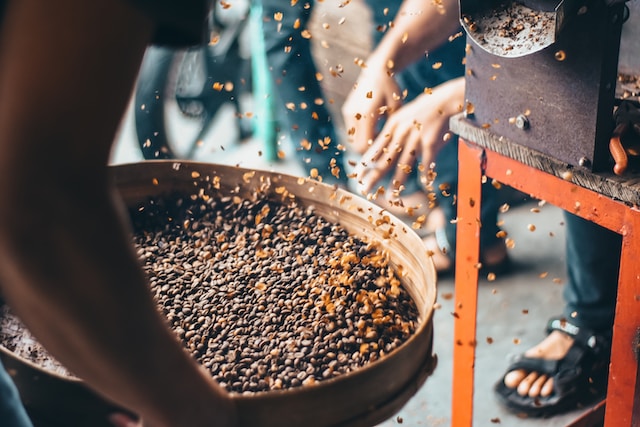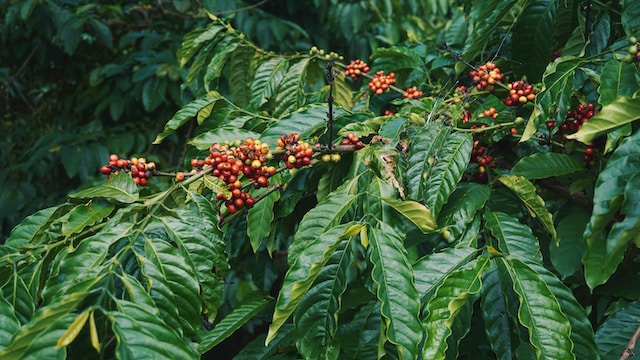The Coffee Cherry: A Superfood With Surprising Super Powers

Heads up: This content is reader-supported, meaning we may earn a small commission if you click on some of our links.
Names can be deceiving. And the coffee cherry is no exception. Despite its name, the coffee cherry is not a cherry at all. It is a fruit that grows on the coffee plant, which is native to tropical regions of Africa.
Ripe coffee cherries vary in color from green to red (and everything in between) and are harvested at the peak ripeness. Inside each cherry are typically two coffee seeds used to make coffee. However, the coffee cherry is also edible and has a unique flavor. Some say it has a sweet and tangy flavor, while others say it tastes like a cross between a cranberry and a watermelon.
Color us intrigued.
Table of Contents
Anatomy of a Coffee Cherry
When you think of coffee, you probably imagine a roasted bean, but it starts as a cherry before it becomes a beautifully roasted coffee bean. A coffee cherry has several layers, each with a purpose. Let’s take a closer look at the anatomy of the coffee cherry.

Exocarp
The exocarp is the outermost layer of the coffee cherry. It is thin and smooth and is often referred to as the skin. This layer protects the coffee cherry from pests and disease.
Mesocarp
Beneath the exocarp is the mesocarp, also known as the pulp. This layer is thicker than the exocarp and is where most of the fruit’s sugars are stored. The mesocarp is important for fermentation, which helps remove the mucilage.

Endocarp
The endocarp, also known as parchment, is the hard layer surrounding the coffee bean. This layer protects the coffee bean from damage and helps regulate moisture.
Silver Skin
The silver skin is the thin layer that covers the coffee bean. It is also known as the epidermis. This layer is removed during roasting and in the form of chaff.

Seed(s)
The seeds are the coffee beans themselves. This is the part of the coffee cherry roasted and used to make coffee. Each seed comprises several layers, including the parenchyma, which stores nutrients.
Typically, a coffee cherry contains two seeds. But about 5% of the time, only one seed forms. While most coffee seeds are flat on one side, a single coffee seed, or peaberry, is round.
Peaberries are considered a desirable defect for many in the specialty coffee sector; however, there is much debate over whether or not they present a unique flavor profile. They are often sold at a premium price and are marketed as having a sweeter flavor.
Whether they are sweeter or not, peaberries should always be sorted from traditional beans as they differ in shape and size and will produce an inconsistent roast if roasted together.

Types of Coffee Plants
There are three main types of coffee plants: Coffea Arabica, Coffea Canephora, and Liberica. Each class has unique characteristics that affect the taste and quality of the coffee beans they produce.
Coffea Arabica
Coffea Arabica is the most popular type of coffee plant, accounting for approximately 70% of the world’s coffee production. It is known for its sweet taste and low acidity, making it a favorite among coffee connoisseurs. Arabica beans are grown at higher elevations and in cooler climates, which gives them a more complex flavor profile.

Coffea Canephora
Coffea Canephora, or Robusta, accounts for about 30% of the world’s coffee production. Robusta beans have a higher caffeine content and a more bitter taste than Arabica beans. They are also more disease-resistant and easier to grow, which makes them a popular choice for mass-produced coffee.
Liberica
Liberica is a less common coffee plant, or coffee tree, accounting for only about 2% of the world’s coffee production. It is known for its unique bean shape and flavor profile, often described as having a smoky or woody aftertaste. Liberica beans are grown in warmer climates and lower elevations than Arabica beans.
Overall, the coffee plant used to produce coffee beans can significantly impact the taste and quality of the coffee. Whether you prefer the sweet taste of Arabica, the high caffeine content of Robusta, or the unique flavor of Liberica, there is a type of coffee plant out there that will suit your tastes.

Coffee Cherry Processing
The cherry is removed from the beans during coffee processing, which can be done in several ways. Here are the three most common methods:
Washed
Washed processing, also known as wet processing, involves removing the cherry from the beans immediately after harvest. The beans are then placed in water tanks, where they can ferment for a while. This process removes the sticky mucilage layer from the beans. The beans are then rewashed to remove any remaining mucilage. Finally, the beans are dried.
Washed processing is known for producing coffee with a clean, bright taste. (the irony of a washed coffee being described as having a clean taste isn’t lost on us) It is also the most labor-intensive processing method, requiring a lot of water and careful attention to detail.

Natural
Natural processing, also known as dry processing, is a traditional method that involves leaving the fruit (skin, pulp, and all) on the beans while they dry. The cherry is removed from the beans once they are completely dry. This method is popular in areas where access to clean water is limited.
Natural processing results in coffee with a fruity, full-bodied taste. However, it is also more prone to defects like over-fermentation, resulting in inconsistent quality.

Honey Process
Honey processing is a hybrid of washed and natural processing. During this method, the outer skin of the cherry is removed, but the sticky mucilage layer is left intact. The beans are then dried with the mucilage layer still attached. This method can result in coffee with a sweet, complex taste.
Honey processing can be done in several variations, including black, red, and yellow honey. The color classification refers to how much mucilage is left on the beans during drying.
The white honey process has the least mucilage, while the black has the most remaining. The amount of mucilage left on the bean will affect the drying time and the final flavor profile.
No matter which processing method is used, the first step is to de-pulp the cherries. This is done with a pulper machine, which removes the outer skin and some fruit from the beans.
Coffee Cherry Products
The coffee cherry byproduct, or cascara, is a versatile ingredient used to make various products. Here are some of the most popular coffee cherry products:
Roasted Coffee Beans
Roasting coffee beans is obviously the most common way to use coffee cherries. The beans are processed using one of the methods above and then roasted to bring out their unique flavor and aroma.
The roasted beans are ground and used to brew coffee through various methods.

Cascara Tea
Cascara tea is made from coffee cherry’s dried skin and pulp (aka waste). It has a sweet and fruity taste that is similar to hibiscus tea. Cascara tea is rich in antioxidants and can be enjoyed hot or cold. It is a great alternative to traditional tea and coffee.
Coffee Fruit Extract
Coffee fruit extracts are made by extracting antioxidants and other beneficial compounds from the coffee cherry. These extracts can be added to products such as capsules, juices, and powders. They are known for their anti-inflammatory and anti-aging properties.

Coffee Cherry Nutrition
The coffee cherry is a superfood packed with nutrients. Here are some of the essential nutritional benefits of coffee cherries:
Antioxidants
Coffee cherries contain antioxidants that help neutralize harmful compounds called free radicals, which can otherwise contribute to cell damage and chronic diseases. The coffee cherry has been shown to have more antioxidants than blueberries, known for their high antioxidant content.
Protein
Coffee cherries are also a good source of protein, with more protein per gram than fresh kale. Protein is essential for building and repairing tissues in the body and for maintaining a healthy immune system.
Polyphenols
Polyphenols are another type of antioxidant found in coffee cherries. These compounds have been shown to have anti-inflammatory and anti-cancer properties. The coffee cherry is particularly rich in a kind of polyphenol called chlorogenic acid, which has several health benefits, including reducing inflammation, improving blood sugar control, and protecting against heart disease.
In addition to chlorogenic acid, coffee cherries also contain quinic acid and diterpenes, other beneficial compounds that have been shown to have health benefits.

Unusual Coffee Cherry Uses
If you thought coffee cherries were only good for making coffee, think again! Here are some unusual uses for coffee cherries that you might not have heard of.
Kopi Luwak
Kopi Luwak coffee is made with beans eaten by the Asian palm civet. The beans are collected from the animal’s feces, cleaned, and roasted. The theory behind this coffee is that the animal will only eat the ripest, tastiest coffee cherries, resulting in a unique and flavorful coffee.
However, the process of collecting the beans has raised concerns about animal welfare, and many coffee experts question the quality and taste of the coffee.
Coffee Cherry Snacks
Coffee cherries can be dried and turned into everything from crunchy snacks to delicious chocolate bars. Upcycled coffee cherry “waste” presents a tasty and nutritious ingredient high in antioxidants and fiber.
Chewing on Coffee Beans
In some cultures, chewing on coffee beans is a common practice. The beans are roasted and then chewed to release their flavor and caffeine. Some people claim that chewing coffee beans can help digestion, freshen your breath, and provide a quick energy boost.
However, it’s important to note that chewing coffee beans can also cause tooth damage and stomach irritation if consumed in large quantities.
Overall, coffee cherries have a lot more to offer than just coffee. Whether you’re interested in trying Kopi Luwak, snacking on coffee cherry treats, or chewing on coffee beans, this versatile fruit has plenty of unique and unusual uses.

from: Koa Coffee
Frequently Asked Questions
What are the health benefits of consuming coffee cherries?
Coffee cherries are packed with nutrients and antioxidants that can boost your health. They contain high levels of vitamin C, potassium, and fiber, which can help improve your immune system, regulate blood pressure, and aid digestion. Additionally, coffee cherries are rich in polyphenols, known to have anti-inflammatory and anti-cancer properties.
What is cascara, and how is it made from coffee cherries?
Cascara is a tea made from the dried skins of coffee cherries. The skins are removed from the cherries and dried in the sun to make cascara. The resulting tea has a fruity, slightly sweet flavor and is often compared to hibiscus tea. Cascara is becoming increasingly popular as a specialty beverage and can be found in many coffee shops and specialty stores.

Can coffee cherries be used to make tea?
As mentioned above, coffee cherries can be used to make cascara tea. The tea has a unique flavor often enjoyed for its fruity and slightly sweet taste. Additionally, some people use coffee cherry tea as a natural energy booster, as it contains caffeine and other natural stimulants.
What is the flavor profile of coffee cherries?
Coffee cherries have a sweet, fruity flavor that is often compared to cranberries or pomegranates. The taste can vary depending on the variety of coffee plants and the processing method used. Additionally, the flavor of coffee cherries can be influenced by the terroir or the environmental factors that affect the growth of the plants. Overall, coffee cherries have a unique and complex flavor profile that is worth exploring.
ABOUT THE AUTHOR
Heather Calatrello
Heather is the head coffee roaster and founder of ShedLight Coffee Roasters in San Diego, CA. Her solar-powered coffee roastery was recently the subject of a BlueDot Living dispatch, and she has repeatedly been featured in Food & Wine, Real Simple, Parade, and more.

